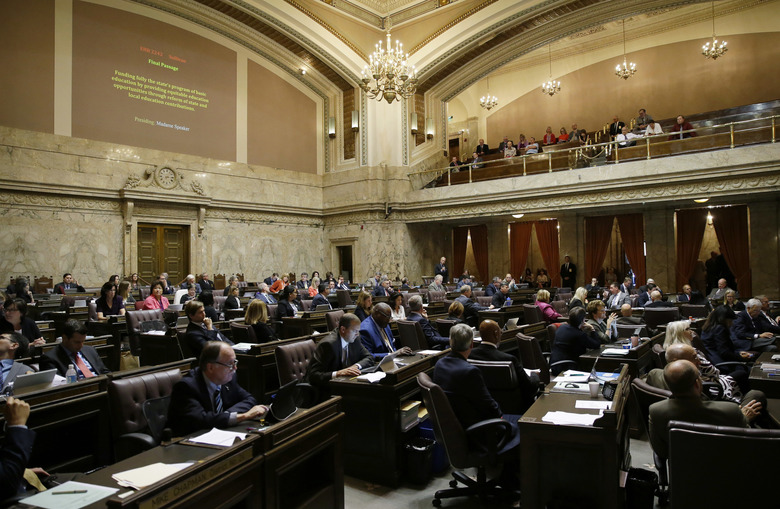
It took the Washington Legislature less than 36 hours in late June to unveil and approve a sweeping overhaul of public education as part of a last-minute budget deal to avert a government shutdown.
It’s taken much more than 36 hours — 36 days, in fact, as of Friday — for local school-district officials to figure out how that budget will affect their districts. And they’re still not clear on just how beneficial the changes will be
“They think they did this really hard, really wonderful thing,” said JoLynn Berge, assistant superintendent for business and finance with Seattle Public Schools, the state’s largest school district.
“I’m not saying it wasn’t hard. I’m just not convinced that it was that wonderful.”
On Monday, the Office of Superintendent of Public Instruction released projections of how the Legislature’s education budget will affect the bottom lines for each of the state’s 295 school districts over the next four years.
The estimates paint a rosy picture, with hefty boosts for virtually all districts. But Berge and some of her counterparts in neighboring districts believe that 30,000-foot view masks some important problems and questions.
They worry, for example, about putting property-poor districts at a handicap in how much they can raise from local taxpayers. Many don’t think the new budget covers all their basic education costs, as lawmakers say it does.
They also worry that voters will not support local levies at all, as lawmakers declare they’ve fully funded the state’s public schools.
“Generally, the thinking is that they (lawmakers) made some progress,” said Brianne King, executive director with the Washington Association of School Business Officials.
“But I think … there’s still a lot of work to be done,” she said. “I hear from people all over that are saying, ‘It (public education) is fully funded.’ Well, no, it’s not. We need to really break it down.”
Last Tuesday, a coalition of school administrators, business officers, school-board members and principals met in Renton to share their impressions of what lawmakers have wrought.
Duggan Harman, chief of staff and finance at Highline Public Schools, attended that meeting and suggested the spending plan’s full impact won’t be known until it’s fully phased-in four years from now.
“Everybody agrees it was a good start, but the cake’s not fully baked yet,” he said, adding that he’s more optimistic than some.
There’s good reason for that optimism: Between state and local funding, Highline schools are expected to get about $265.2 million in the 2018-19 school year, up from a current $213.4 million. And that total ramps up to $278.3 million, or more than $14,000 per student, by full implementation in 2020-21.
But he also echoed a concern that he said everyone at the meeting shared — the potential for inequity when it comes to local levies.
Starting in calendar year 2019, districts can set a levy rate of $1.50 per $1,000 of assessed value or a rate that generates $2,500 per student, whichever is lower.
Seattle, a “property wealthy” district, will use the latter formula, and Berge expects a 60- to 70-cent levy rate will yield the $2,500 target. And with ever-rising property values, Seattle taxpayers could see that rate drop even lower over the next several years.
Meanwhile, “property poor” districts like Highline will have to rely on the higher $1.50 rate — which still may not generate much money.
The state has pledged to help districts like Highline, ensuring they get at least an extra $1,500 per student. But the coalition members questioned why that minimum wasn’t $2,500, like Seattle and other property-rich districts will likely collect.
“It does seem like a gap is built in,” said Arik Korman, spokesman for the nonpartisan League of Education Voters
“Really, time will tell,” Korman added.
Districts have discovered one silver lining.
In general, the state’s budget will raise state property taxes for schools, while lowering local ones.
But for about six months in 2018, districts will benefit from the higher state property taxes, and aren’t yet required to lower their local ones.
That means districts essentially can double dip for that period, while taxpayers temporarily foot both of the higher tax rates.
“There will be a brief overlap there which will make 18-19 (the 2018-19 school year) easier for districts,” Harman said.
That extra money won’t help much if voters, as districts fear, don’t support local levies as regularly as they have in the past.
As early as this coming February, voters in some districts head to the polls to consider newly named “enrichment” levies, which used to be called maintenance and operations (M&O) levies. In the past, they paid for extras, but also basic education costs that the state failed to cover.
Lawmakers have declared that the state now will fully cover all basic education costs. While many district officials beg to differ, they also worry voters will hear that message and vote down local school levies.
Seattle taxpayers won’t see an “enrichment” levy on their ballots until February 2019, but Berge said districts that have a measure next year have reason to worry.
“Words matter. How people interpret something matters,” she said.
“When the public’s told basic education is funded — totally — then passing an enrichment levy versus an M&O levy has a different connotation for taxpayers who just got a much bigger tax bill” from the state, Berge said.
[“Source-seattletimes”]
